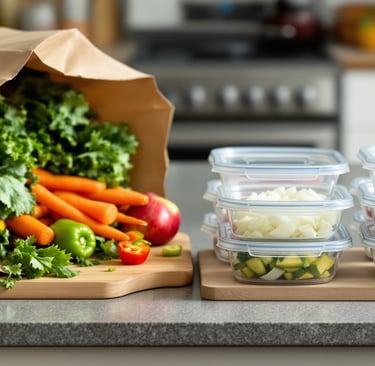Subscribe now for exclusive meal discounts!
Order by Nov 18th 11:59PM MST, and get your meals delivered on the 23rd.
How to Create a Balanced Weekly Menu That Works
Learn how to optimize your weekly menu so you don't get bored.
Jeramy Udy
11/6/20254 min read


Creating a balanced weekly menu might sound like a chore, but it's actually one of the best things you can do for your health, wallet, and sanity. When you plan your meals ahead of time, you're more likely to eat nutritious foods, spend less on groceries, and avoid that dreaded "what's for dinner?" panic. Let me show you how to create a weekly menu that's both healthy and practical.
Why Bother With Meal Planning?
Before diving into the how-to, let's talk about why meal planning is worth your time:
• It saves money by reducing impulse purchases and food waste
• It saves time by cutting down on store trips and daily cooking decisions
• It improves nutrition by ensuring balanced meals throughout the week
• It reduces stress by eliminating the daily dinner dilemma
• It helps manage special diets or health goals more effectively
Step 1: Take Stock of What You Already Have
Start in your kitchen! Check your pantry, refrigerator, and freezer. Make note of items that need to be used soon to prevent waste. This step alone can save you money and help inspire meal ideas based on what you already have.
Quick tip: Keep a running inventory of your pantry staples on your phone, so you always know what you have on hand.
Step 2: Consider Your Schedule
Look at your upcoming week. Which nights will you be home late? Which days might you have more time to cook? Be realistic about your schedule when planning meals.
For busy nights, plan simple meals or consider using a slow cooker. For nights with more time, you might tackle that new recipe you've been wanting to try. Match meal complexity to your available time.
Step 3: Build a Balanced Plate for Each Meal
A balanced meal typically includes:
• Protein (meat, fish, eggs, tofu, beans)
• Complex carbohydrates (whole grains, starchy vegetables)
• Vegetables and/or fruits
• Healthy fats (olive oil, avocado, nuts)
Try to include foods from each category in most meals. This doesn't mean every meal needs to be perfect, but aim for balance across the day and week.
Step 4: Plan Around Sales and Seasonal Foods
Check store flyers or apps to see what's on sale. Seasonal produce is usually fresher, tastier, and less expensive. Build some of your meals around these items to maximize quality while minimizing cost.
Summer might mean fresh berries and tomatoes, while winter calls for hearty root vegetables and citrus. Working with the seasons makes meal planning more interesting and economical.
Step 5: Include Variety While Keeping It Simple
Variety is important for both nutrition and preventing mealtime boredom, but don't overcomplicate things. Consider these strategies:
• Theme nights: Taco Tuesday, Pasta Wednesday, Stir-Fry Friday
• Protein rotation: Aim for different protein sources throughout the week
• Color diversity: Different colored fruits and vegetables provide different nutrients
• Reuse ingredients: Use leftover roasted chicken in a salad the next day
Step 6: Create Your Shopping List
Once you've planned your meals, make a detailed shopping list organized by store sections (produce, dairy, meat, etc.). This makes shopping more efficient and helps you stick to buying only what you need.
Add quantities to your list to avoid buying too much or too little. Don't forget to include breakfast, lunch, and snack items.
Step 7: Prep Components in Advance
Set aside an hour or two after grocery shopping to prep some components. This doesn't mean cooking entire meals—just tackling the time-consuming parts:
• Wash and chop vegetables
• Cook grains like rice or quinoa
• Marinate proteins
• Make sauces or dressings
Even small prep steps can make weeknight cooking much faster.
Sample Balanced Weekly Menu
Here's what a balanced weekly menu might look like:
Monday: Baked salmon with roasted sweet potatoes and broccoli
Tuesday: Bean and vegetable tacos with avocado
Wednesday: Chicken stir-fry with brown rice and mixed vegetables
Thursday: Lentil soup with whole grain bread and side salad
Friday: Homemade pizza with veggies and a side salad
Saturday: Grilled steak with quinoa and roasted vegetables
Sunday: Vegetable and chickpea curry with brown rice
Common Meal Planning Mistakes to Avoid
• Planning too many complex recipes in one week
• Not accounting for leftovers
• Ignoring your schedule realities
• Choosing recipes with too many specialty ingredients
• Not building in flexibility for unexpected changes
Staying Flexible
Remember that your meal plan is a helpful guide, not a strict rule book. Life happens! It's perfectly fine to swap meals around or have a backup plan (like a simple pasta dish or a frozen meal) for when things don't go as expected.
Keep a list of 5-10 easy meals you can make from pantry staples for those nights when plans fall through.
Making It a Habit
Start small if you're new to meal planning. Try planning just 3-4 days at first, then work your way up to a full week. Use digital tools like meal planning apps, or go old-school with a simple notebook.
Many people find Sunday is a good planning day, but choose whatever works for your schedule. The key is consistency—make it part of your regular routine.
The Bottom Line
Creating a balanced weekly menu doesn't have to be complicated. With a bit of planning, you'll enjoy healthier meals, save money, reduce waste, and eliminate daily meal decision stress.
Start with the simple steps outlined here, adapt them to your lifestyle, and watch how meal planning transforms your relationship with food and cooking. Your future self will thank you when dinnertime rolls around and you already know exactly what's on the menu!
Subscribe Now
Explore our delicious weekly meal plans today!
info@chefmealplans.com
435-279-3148
© 2025. All rights reserved.
